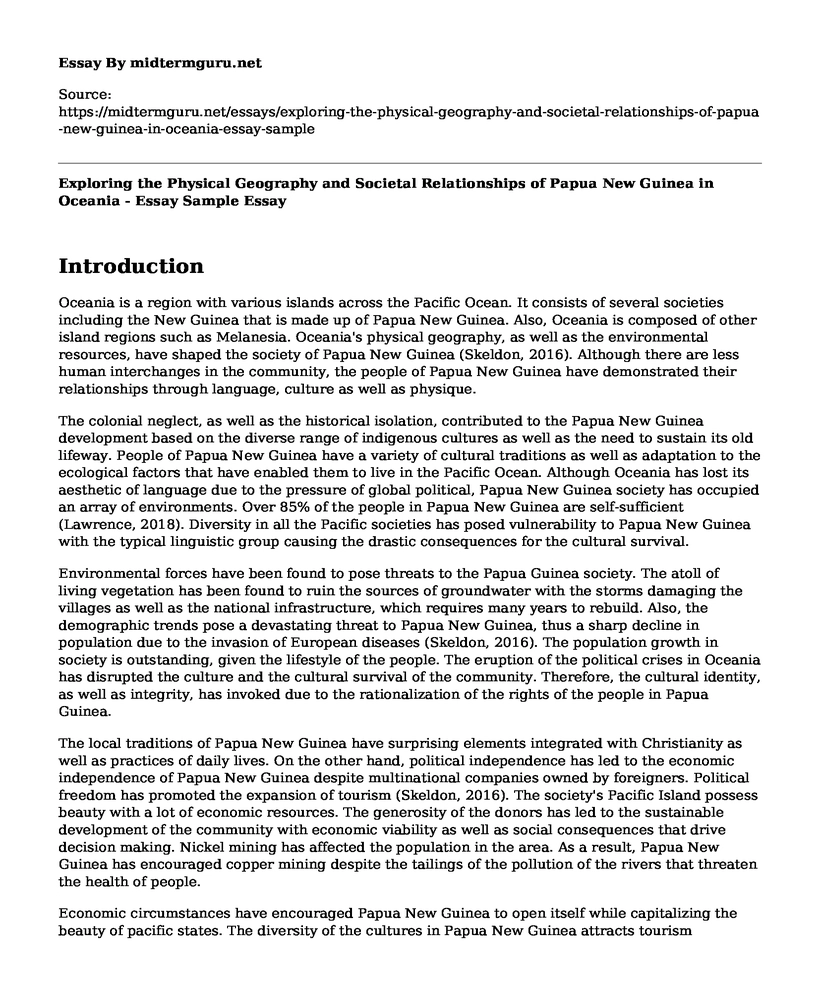Introduction
Oceania is a region with various islands across the Pacific Ocean. It consists of several societies including the New Guinea that is made up of Papua New Guinea. Also, Oceania is composed of other island regions such as Melanesia. Oceania's physical geography, as well as the environmental resources, have shaped the society of Papua New Guinea (Skeldon, 2016). Although there are less human interchanges in the community, the people of Papua New Guinea have demonstrated their relationships through language, culture as well as physique.
The colonial neglect, as well as the historical isolation, contributed to the Papua New Guinea development based on the diverse range of indigenous cultures as well as the need to sustain its old lifeway. People of Papua New Guinea have a variety of cultural traditions as well as adaptation to the ecological factors that have enabled them to live in the Pacific Ocean. Although Oceania has lost its aesthetic of language due to the pressure of global political, Papua New Guinea society has occupied an array of environments. Over 85% of the people in Papua New Guinea are self-sufficient (Lawrence, 2018). Diversity in all the Pacific societies has posed vulnerability to Papua New Guinea with the typical linguistic group causing the drastic consequences for the cultural survival.
Environmental forces have been found to pose threats to the Papua Guinea society. The atoll of living vegetation has been found to ruin the sources of groundwater with the storms damaging the villages as well as the national infrastructure, which requires many years to rebuild. Also, the demographic trends pose a devastating threat to Papua New Guinea, thus a sharp decline in population due to the invasion of European diseases (Skeldon, 2016). The population growth in society is outstanding, given the lifestyle of the people. The eruption of the political crises in Oceania has disrupted the culture and the cultural survival of the community. Therefore, the cultural identity, as well as integrity, has invoked due to the rationalization of the rights of the people in Papua Guinea.
The local traditions of Papua New Guinea have surprising elements integrated with Christianity as well as practices of daily lives. On the other hand, political independence has led to the economic independence of Papua New Guinea despite multinational companies owned by foreigners. Political freedom has promoted the expansion of tourism (Skeldon, 2016). The society's Pacific Island possess beauty with a lot of economic resources. The generosity of the donors has led to the sustainable development of the community with economic viability as well as social consequences that drive decision making. Nickel mining has affected the population in the area. As a result, Papua New Guinea has encouraged copper mining despite the tailings of the pollution of the rivers that threaten the health of people.
Economic circumstances have encouraged Papua New Guinea to open itself while capitalizing the beauty of pacific states. The diversity of the cultures in Papua New Guinea attracts tourism (Lawrence, 2018). Although tourism has been found to bring income and information to society, it endangers the environment, thus providing poorly paid services. Papua New Guinea is, therefore, working towards promoting informed as well as well-controlled tourism that does not undermine the indigenous cultures.
Conclusion
In conclusion, Papua New Guinea has demonstrated their cultural unification through diversification with various indigenous groups as well as indigenous languages. Recognition of indigenous groups in Papua New Guinea has promoted traditional practices as part of the contemporary culture. The cultural practices such as sports and arts have reunited Oceania's people that were isolated initially.
References
Lawrence, Peter. "Twenty years after reconsideration of Papua New Guinea seaboard and
highlands religions." Oceania, vol. 59, no. 1, 2018, pp. 7-27., doi:10.1002/j.1834-4461.1988.tb02300.x.
Skeldon, Ronald. "Regional associations among urban migrants in Papua New
Guinea." Oceania, vol. 50, no. 4, 2016, pp. 248-272., doi:10.1002/j.1834-4461.1980.tb01409.x.
Cite this page
Exploring the Physical Geography and Societal Relationships of Papua New Guinea in Oceania - Essay Sample. (2023, Feb 07). Retrieved from https://midtermguru.com/essays/exploring-the-physical-geography-and-societal-relationships-of-papua-new-guinea-in-oceania-essay-sample
If you are the original author of this essay and no longer wish to have it published on the midtermguru.com website, please click below to request its removal:
- Paper on Financial Mathematics: Calculating the Value of Annuities
- Essay on Multiculturalism in Workplace: My Experience of Interacting With People From Different Ethnic Communities
- The Tragedy of the Commons - Essay Sample
- Education in America: How It Has Changed Over Time - Essay Sample
- Finding Love on the Internet - Essay Sample
- Paper Example on Rethinking Race, Class, Language, and Gender
- Paper Example on Organizational Behavior: The Impact of Diversity in the Workplace and Organizations







